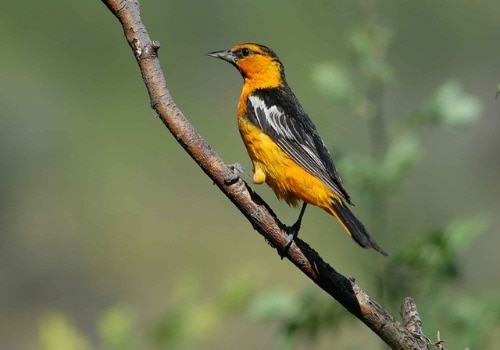There is nothing more beautiful than seeing different types of birds in your backyard devouring some seeds. Some of these stunning birds have the same size, shape, and even color combinations, but did you know there is a way to group them?
Well...
Despite the different color patterns, some species have the same color on certain parts of their bodies and, in this case, the chest or bellies. So in this article, we will elaborate more on the different orange-breasted birds.
10 Birds With Orange Chest
Do you love the color orange? Well, you're in luck! Today, we are exploring the different birds with orange breasts on the planet, and you'll discover that there are hundreds of these birds.
However, most of them are songbirds, but there are other species from different orders.
So we'll ensure that the next time you notice an orange belly bird, you can do more than just identify it. We'll make sure you differentiate it from others and teach you some of their peculiar behaviors.
Here are some of the most common birds with an orange belly:
1. Allen's Hummingbird
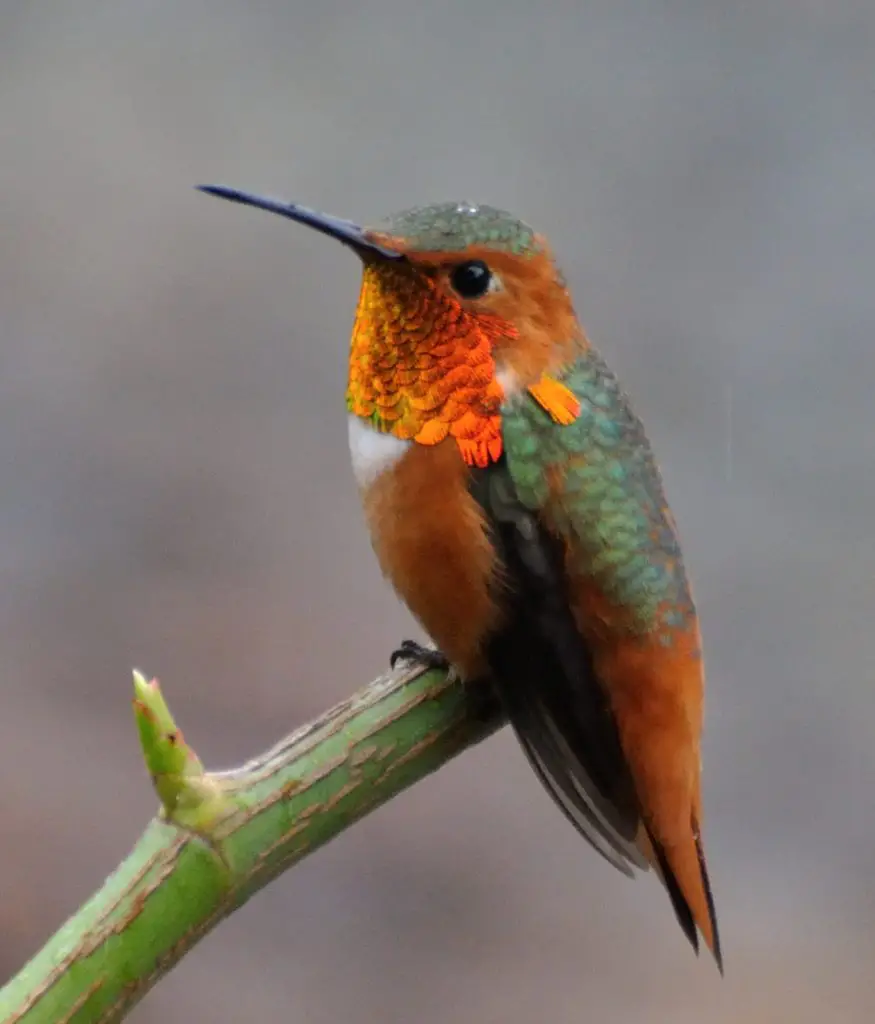
Compared to most birds in North America, Allen's Hummingbird is an early migrant. Therefore, unlike other northbound birds, they normally leave their wintering ground before December and get to their breeding spots as early as January. So you might notice these small birds earlier than others.
But don't ever mistake their size for weakness; after all, it does have an attitude or, should I say, altitude.
An exceptional fact about this orange chested bird is that it's a high diving species.
Other than being early migrants, their color pattern can help you spot it easily; in fact, their perfect color combination of green and copper upper and reddish-orange marks the beginning of spring along the Pacific Coast.
Interestingly enough, the females and the males don't use the same habitat during the breeding season. Normally, the females will visit the male, who lives in an open area for mating before returning to the thicket or forest to nest.
The males flash their reddish-orange throats to attract females while swinging in pendulous arcs and flying high before diving down while producing a sharp squeal using their tails. They usually meet on a narrow strip along California and coastal Oregon in North America during the breeding season.
They feed on nectar, small insects, and tree saps. The most effective method for attracting them to your feeder is by providing them with some sugar water.
2. American Robin
If there is one breed that can be found in every corner of North America, even Alaska, is the American Robin. You can even spot it in Europe; plus, it is the national bird of the United Kingdom and one of the most popular British birds. Well, as it turns out, this breed thrives in any climate, but they do have a short lifespan (2 years).
Luckily, this Orange breasted bird knows how to make the most out of its short lifespan. And they have been known to get drunk.
American Robin tends to gorge on fermented berries and then starts demonstrating some weird behaviors like toppling over when walking.
Being colorful creatures, they have a gray upper part but don't be surprised when you see their lovely orange chest and white underside. Facially, they have blackheads, yellowish bills, and white eyering that make them stand out.
Like most small birds, they love roosting on trees in winter, so you may start seeing them come spring all over your backyard. Plus, only the ones living in Alaska and Canada are known to migrate come winter. These beauties dine on berries, earthworms, grasshoppers, and caterpillars.
3. American Woodcock
Situated in Northeastern parts of America, the American Woodcock lives longer than the Robins. They are exceptional foragers; plus, the position of their eyes makes it possible for them to watch out for predators above and around them at the same time; therefore, surprising this bird is almost impossible.
Unlike most orange-chested birds, the American Woodcock has an Achille's heel, which is a form of weakness, especially when startled.
This orange breasted bird tends to freeze for a few seconds before flying away if startled. This has resulted in the death of most of them after freezing on the roads.
Unlike most animals, they have a mixture of 6 colors on their back and face (light-brown, gray, black, and tan). Its color extends to its breast like backpack straps. But it will surprise you when it spreads its wings thanks to its beautiful orange chest.
While earthworms account for almost half of their diet, they also consume flies, centipedes, and beetles.
4. Baltimore Oriole
Like most birds, the Baltimore Orioles can be found in Canada and the eastern parts of the United States. But they tend to migrate to warmer places like Central and South America in winter.
If you think you have never seen some beautiful nests, then you haven't seen what the Baltimore Orioles can create.
The females can spend up to 8 days weaving a hanging nest using strings, hair, and grasses during the breeding season.
These nests are so strong that they use them more than twice in their lifetime.
This small bird has a perfect combination of orange and white that makes them stand out, especially in winter against the white background. They have yellowish-orange plumage.
The Icterus galbula, which is their scientific name, has a varied diet that includes flowers, fruits, mealworms, insects, and wasps.
5. Barn Swallow
Similar to the Baltimore Orioles, the Barn Swallows winter is in South and Central America, but you can find them all over the U.S. during the warmer months. These smaller birds have a myth around them that has given them a bit of fame.
According to a native American myth, it got its forked tail after it boldly flew to the sun, stole fire from the gods, and handed it over to humans.
Therefore, one of the gods got angry and threw a firebrand and burned the middle part of its tail.
Other than its exceptional tail, the other thing that helps it stand out is its bluish upper part and reddish-orange chest. Its face has an even deeper orange-red color than the other parts. These insectivorous birds consume flies, beetles, grasshoppers, and moths.
6. Black-Headed Grosbeak
As it turns out, male Black-headed Grosbeaks make exceptional fathers. They spend time with the females during the incubation period and even help raise the chicks once they hatch. Therefore, if you want to see a couple raising their chicks together, you should look for this orange belly bird.
Another superpower that these birds have is the ability to consume the highly toxic Monarch butterflies without becoming sick.
Their specialized digestive system allows them to digest these butterflies without allowing the toxin too much time to be digested and harm the birds.
Differentiating the males from the females is quite easy; all you have to watch out for are their color. After all, the latter is usually brown in color. On the other hand, the males have black backs, blackhead, and white wings.
Occasionally, they are known to consume snails whose shells are no match for them. They also dine on fruits and grains.
Read Also: Orange And Black Birds
7. Bullocks Oriole
As one of the most colorful species on the planet, they are quite observant. In fact, they're known to leave their eggs in the nest of an unsuspecting bird so that their chicks can be reared by foster parents.
Most birds fall for this, but not the Baltimore Orioles who will puncture those eggs when they see them.
You haven't seen some beautiful birds until you see this species. The Bullock has black wings, but wait until you see their beautiful chest, when they spread their wings. But they don't have the same color. The females have a different color combination; they are more yellowish-orange.
They consume small insects, nectar, and fruits.
8. Eastern Bluebird
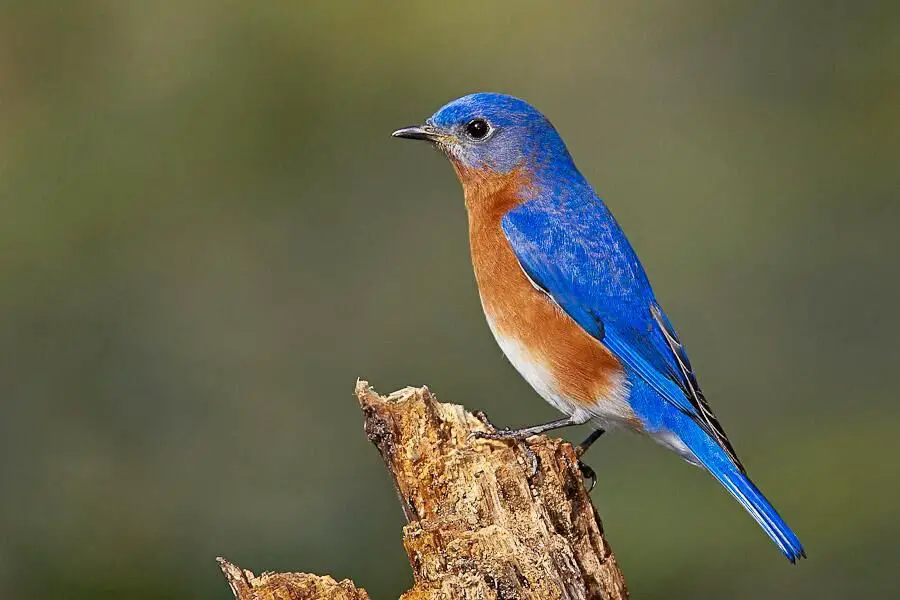
Attracting the Eastern Bluebirds to your backyard can be quite tricky, especially since they are very picky. So here is a tip, simply make sure the box is cozy and has an entry with a diameter of about 1.75 inches, and being a year-round resident of the United States, you should expect to see them flying all over your yard.
One thing that makes it stand out is its sharp eyesight that can spot a bug as far as over 60ft away.
And if you think their blue backs are lovely, wait until they flap their wings; these birds have an orange belly that stretches to the throat. The females are more grayish-blue in color. The main difference between this bird and the male Western bluebird is that the latter has a bright blue chin and neck.
They feast on beetles, crickets, caterpillars, berries, and fruits.
9. Orange-Breasted Sunbird
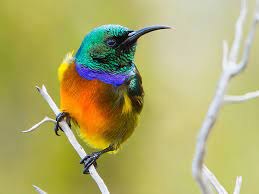
Our list would be incomplete if we didn't include the beautiful bird from South Africa, which has a lifespan of about 22 years.
Like the Baltimore Orioles, the Orange-breasted sunbirds also take care of their chicks together, but the males are a bit lazy.
They usually take care of them for 3 weeks before letting them fend for themselves.
This stunning creature is the only one on our list with a turquoise top and a mixture of gray and orange breasts. But still, it is a stunning bird that can outlive most bird species. They feed on nectar, spiders, and small insects.
10. Orange-Breasted Waxbill
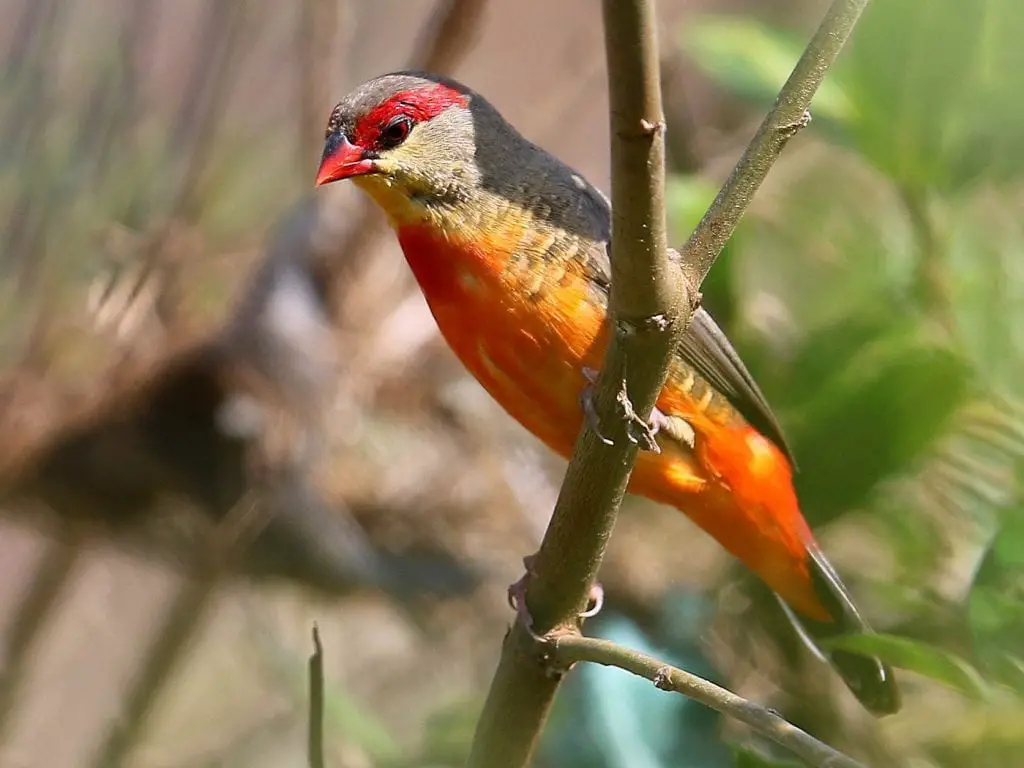
Another exceptional entry from the grasslands and savannas of the Sahara is the Orange-breasted Waxbill.
Being the smallest members of the Estrildid Finch family and with great temperament, they are loved in the local pet world.
Unlike more birds that travel in groups, these ones travel in pairs since the breeding season turns the males into aggressive creatures. After mating, they have to stay there and protect the eggs from predators like the Red-Collared Widowbird.
Africa is home to some of the most beautiful birds, and this one is no exception. These waxbills have gray and olive backs and tails. Don't forget their rich-orange chests flank the olive coloration, giving it a stunning look.
They feed on small crickets, maggots, termites, mealworms, and grass seeds.
Frequently Asked Questions
How Do You Identify the Varied Thrush?
Varied thrush has the same color pattern but different colors, with the females being paler than the males. On the other hand, the male varied thrush has a rich burnt-orange belly. Like most orange belly birds, they have an orange line over their eyes.
How Can You Differentiate a House Finch From a Purple Finch?
Purple finches are dark pink feathers just like red wine or raspberry, while the house finches are red-orange or classic red, just like strawberries.
What Is the Difference Between the Hooded Oriole and the Orchard Oriole?
Since immature males and female Hooded Orioles can be distinguished from the Orchard Orioles by their size, the Hooded orioles are slightly bigger and have long curved bills and tails. The hooded birds also come with thinner wing bars.
Are There Orange Birds?
Yes! There are hundreds of orange birds on the planet belonging to different families from hummingbirds, orioles, doves, California towhee, and thrush parrots, among other exotic species on the planet.
In fact, most of them get their orange plumage from the carotenoid pigment in their food. The structure of the feather also plays a key role in the overall color of the bird's chest.
Read Also: Types of Real Pink Birds
Conclusion
Well, there you have it; I hope you've enjoyed and learned something from our listing of the orange-bellied birds. As you have noticed, the orange color appears on different species, including the Altamira Oriole, northern cardinal, American redstart American crow, mourning dove, American goldfinch, and summer tanager, among others.
Therefore, you will always have something to watch out for and even know the species before it flies out of your backyard.
